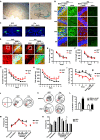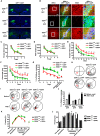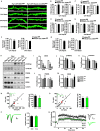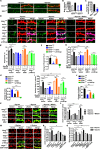Endophilin A1 Promotes Actin Polymerization in Dendritic Spines Required for Synaptic Potentiation
- PMID: 29892212
- PMCID: PMC5985315
- DOI: 10.3389/fnmol.2018.00177
Endophilin A1 Promotes Actin Polymerization in Dendritic Spines Required for Synaptic Potentiation
Abstract
Endophilin A1 is a member of the N-BAR domain-containing endophilin A protein family that is involved in membrane dynamics and trafficking. At the presynaptic terminal, endophilin As participate in synaptic vesicle recycling and autophagosome formation. By gene knockout studies, here we report that postsynaptic endophilin A1 functions in synaptic plasticity. Ablation of endophilin A1 in the hippocampal CA1 region of mature mouse brain impairs long-term spatial and contextual fear memory. Its loss in CA1 neurons postsynaptic of the Schaffer collateral pathway causes impairment in their AMPA-type glutamate receptor-mediated synaptic transmission and long-term potentiation. In KO neurons, defects in the structural and functional plasticity of dendritic spines can be rescued by overexpression of endophilin A1 but not A2 or A3. Further, endophilin A1 promotes actin polymerization in dendritic spines during synaptic potentiation. These findings reveal a physiological role of endophilin A1 distinct from that of other endophilin As at the postsynaptic site.
Keywords: AMPAR; actin polymerization; dendritic spine; endophilin A1; learning and memory; structural plasticity; synaptic potentiation; synaptic transmission.
Figures






Similar articles
-
Endophilin A1 drives acute structural plasticity of dendritic spines in response to Ca2+/calmodulin.J Cell Biol. 2021 Jun 7;220(6):e202007172. doi: 10.1083/jcb.202007172. Epub 2021 May 14. J Cell Biol. 2021. PMID: 33988695 Free PMC article.
-
Endophilin A1 regulates dendritic spine morphogenesis and stability through interaction with p140Cap.Cell Res. 2015 Apr;25(4):496-516. doi: 10.1038/cr.2015.31. Epub 2015 Mar 13. Cell Res. 2015. PMID: 25771685 Free PMC article.
-
Perinatal undernutrition attenuates field excitatory postsynaptic potentials and influences dendritic spine density and morphology in hippocampus of male rat offspring.Neuroscience. 2013 Aug 6;244:31-41. doi: 10.1016/j.neuroscience.2013.03.061. Epub 2013 Apr 6. Neuroscience. 2013. PMID: 23570795
-
Regulation of neuronal PKA signaling through AKAP targeting dynamics.Eur J Cell Biol. 2006 Jul;85(7):627-33. doi: 10.1016/j.ejcb.2006.01.010. Epub 2006 Feb 28. Eur J Cell Biol. 2006. PMID: 16504338 Review.
-
Role of Drebrin in Synaptic Plasticity.Adv Exp Med Biol. 2017;1006:183-201. doi: 10.1007/978-4-431-56550-5_11. Adv Exp Med Biol. 2017. PMID: 28865021 Review.
Cited by
-
Postsynaptic Neuroligin-1 Mediates Presynaptic Endocytosis During Neuronal Activity.Front Mol Neurosci. 2021 Oct 8;14:744845. doi: 10.3389/fnmol.2021.744845. eCollection 2021. Front Mol Neurosci. 2021. PMID: 34690694 Free PMC article.
-
Endophilin A1 drives acute structural plasticity of dendritic spines in response to Ca2+/calmodulin.J Cell Biol. 2021 Jun 7;220(6):e202007172. doi: 10.1083/jcb.202007172. Epub 2021 May 14. J Cell Biol. 2021. PMID: 33988695 Free PMC article.
-
E-Syt1 Regulates Neuronal Activity-Dependent Endoplasmic Reticulum-Plasma Membrane Junctions and Surface Expression of AMPA Receptors.Contact (Thousand Oaks). 2023 Jul 12;6:25152564231185011. doi: 10.1177/25152564231185011. eCollection 2023 Jan-Dec. Contact (Thousand Oaks). 2023. PMID: 37484831 Free PMC article.
-
The β-Carboline Harmine Induces Actin Dynamic Remodeling and Abrogates the Malignant Phenotype in Tumorigenic Cells.Cells. 2020 May 8;9(5):1168. doi: 10.3390/cells9051168. Cells. 2020. PMID: 32397195 Free PMC article.
-
Anterograde Viral Tracer Herpes Simplex Virus 1 Strain H129 Transports Primarily as Capsids in Cortical Neuron Axons.J Virol. 2020 Mar 31;94(8):e01957-19. doi: 10.1128/JVI.01957-19. Print 2020 Mar 31. J Virol. 2020. PMID: 31969440 Free PMC article.
References
LinkOut - more resources
Full Text Sources
Other Literature Sources
Molecular Biology Databases
Research Materials
Miscellaneous

